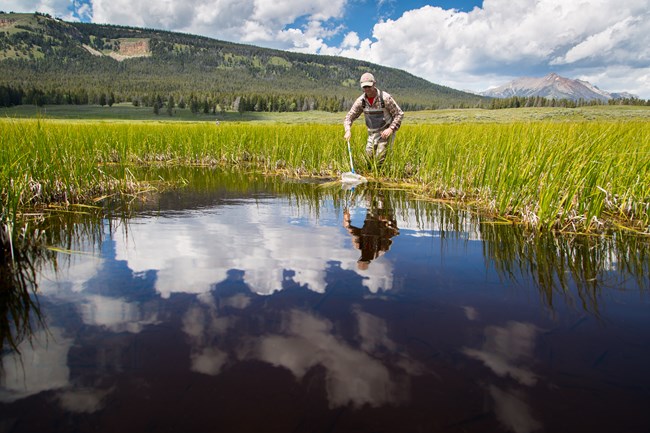
From Yellowstone Science 23(2): 2015, pages 88-89. Sarah Haas There is little to compare with spending a day in Yellowstone's backcountry. By departing the busy roadways and parking lots and entering into the wildness of open space, the true personality of Yellowstone can come to life. That's how I spent a perfect day in June—roaming the sagebrush of the northern range with the NPS Greater Yellowstone Network Inventory and Monitoring crew. Our goal was to locate a cluster of wetlands and small pockets of habitat that support elusive, highly camouflaged creatures beneath the shadows of Quadrant Mountain. Yellowstone, though famous for hydrothermal features that shoot water into the air, is not known for its wetlands or amphibians. There is a reason for that. Both are quite rare in the park;and if you're not looking, you can easily miss them.Representing less than 3% of the total land area within the park, wetlands (including ponds, wet meadows, and marshes bordering lakes and rivers) are uncommon. For amphibians, life in a limited, widely dispersed resource can be tough. There are five native amphibian species documented in the park: Columbia spotted frog (Rana luteiventris), boreal chorus frog (Pseudacris maculata), western tiger salamander (Ambystoma mavortium), boreal toad (Anaxyrus boreas) and, most recently, a single sighting of a spadefoot toad (Spea bombifrons) added one more to the species list. The boreal chorus frog appears to be the most common and widespread throughout the park, but likely remains undetected by almost all visitors except in the spring when the chorusing of these tiny frogs can be heard near wetlands. Dependent on wetlands for completing a successful life cycle, the chorus frog and all of the park's amphibians are linked to the fate of a resource in decline;and population monitoring is revealing this correlation in troubling trends. Wetland and amphibian monitoring has been conducted annually in the park for nearly 15 years through collaborative efforts by the NPS, U.S. Geological Survey, university, and non-governmental cooperators. Monitoring results indicate amphibian populations are vulnerable to regionally detected climate trends of increasing temperatures that contribute to declines in annual snowpacks and runoff. This combination of hotter, drier conditions leads to the drying of wetlands and ponds.If continuous drought conditions are added to the mix, the result may be the loss of wetlands and displacement or local extirpation of the multitude of species that rely on them for survival. Add disease agents such as ranavirus and chytrid fungus to the equation (both detected within the park) which can also affect survival and reproduction, and it becomes clear that amphibians are a vulnerable species on many levels. Amphibians have been identified as a native species "vital sign" for monitoring, due to their role as indicators of ecosystem health from threats such as pollution, habitat loss, and climate change.Keeping a close eye on wetlands and their amphibian populations may assist park managers with answering multiple questions about the status of the Yellowstone environment, and offer insight on the trends of habitats and species that are vulnerable to even subtle environmental change. A committed fan of the underdog, I was happy to participate in searching for a class of animals that have so many factors weighing against them. The method of detection is fairly simple, yet requires a trained eye and attention to detail. Dr. Andrew Ray was the organizer of my day in the field. As an aquatic ecologist with the NPS Greater Yellowstone Inventory and Monitoring team, Dr. Ray is the program lead who coordinates with collaborators and monitoring crews every season to monitor Yellowstone and Grand Teton national parks' wetlands and amphibian populations.Measurements on the size, depth, and water temperatures of each surveyed wetland are gathered along with a description of the vegetation composition of each survey area. A team of at least two surveyors independently circle the water body and regularly sweep pond water using a net. Contents of the net are then examined for signs of amphibian life: egg, larvae, and metamorphic forms of frogs, toads, and salamanders. Adults are also documented, but move away from wetlands after breeding and are therefore more difficult to detect than their early life stages. We were fortunate that field day in June. We found all the species in the remote wetland sites that were previously detected, marking another season where the "present" box could be checked on the data forms. The future is not so certain though, and existing populations can quickly turn to "previously occupied" within a matter of one or two years. Keeping track of what we have on our public lands can be a double-edged sword.We are often in the business of monitoring loss, rather than the preservation of ecosystem integrity. Underdogs, however, should never be written off;even if they don't win the race, they can teach us valuable lessons.This is a race worth watching. |
Last updated: December 21, 2015
